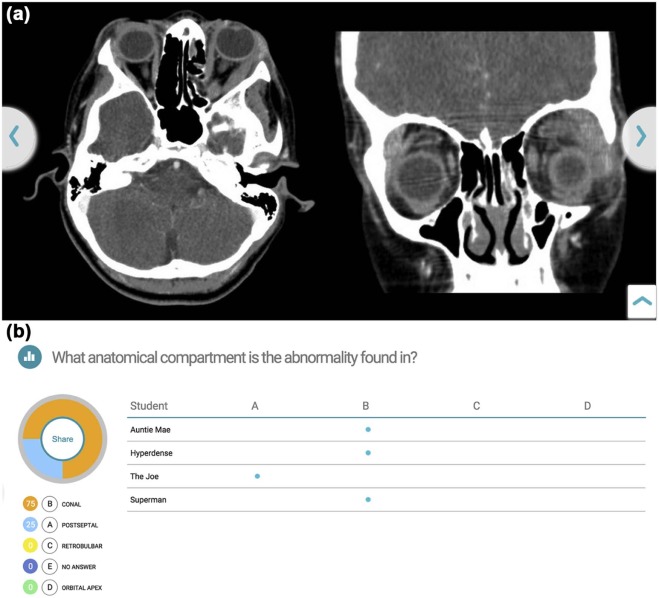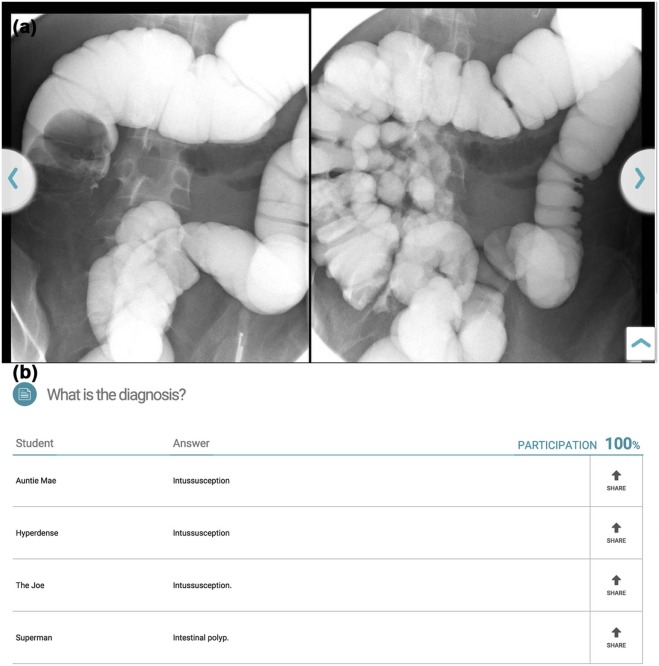Rationale and Objectives
Diagnostic radiology resident assessment has evolved from a traditional oral examination to computerized testing. Teaching faculty struggle to reconcile the differences between traditional teaching methods and residents’ new preferences for computerized testing models generated by new examination styles. We aim to summarize the collective experiences of senior residents at three different teaching hospitals who participated in case review sessions using a computer-based, interactive, anonymous teaching tool, rather than the Socratic method.
Materials and Methods
Feedback was collected from radiology residents following participation in a senior resident case review session using Nearpod, which allows residents to anonymously respond to the teaching material.
Results
Subjective resident feedback was uniformly enthusiastic. Ninety percent of residents favor a case-based board review incorporating multiple-choice questions, and 94% favor an anonymous response system.
Conclusions
Nearpod allows for inclusion of multiple-choice questions while also providing direct feedback to the teaching faculty, helping to direct the instruction and clarify residents’ gaps in knowledge before the Core Examination.
Introduction
In 2013, substantive measures were implemented to change the assessment method used for board certification of diagnostic radiologists. These changes created a gap between how radiology faculty members have traditionally taught residents and how residents are now assessed for board certification. Here, we discuss how synchrony between faculty preparation of our residents for board certification testing can be achieved using audience response systems on portable computing devices, in an anonymous manner.
Diagnostic radiology candidates undergoing assessment for initial certification by the American Board of Radiology (ABR) have now transitioned from the long-standing certification process including an oral qualifying examination as the third and final step, to an assessment using two computerized examinations . First, the Core Examination is offered 36 months after commencement of their radiology residency training. This examination is administered over a 2-day period and assesses comprehension of anatomy, pathophysiology, all aspects of diagnostic radiology, and physics concepts relevant to diagnostic radiology. Categories tested include the following: breast imaging, cardiac, computed tomography, gastrointestinal, interventional radiology, magnetic resonance imaging, musculoskeletal, neuroradiology, nuclear medicine, pediatrics, physics, radiography or fluoroscopy, reproductive endocrinology, Radioisotope Safety Exam, safety, thoracic, ultrasound, and urinary. Whereas multiple-choice questions assessing the application of physics in radiology are integrated into each category, their composite score is calculated as a separate component of the examination score . If a candidate fails up to five categories, he or she must repeat testing in these categories. If a candidate fails more than five categories, the entire examination must be repeated . A candidate must pass the Core Examination before being eligible to take the Certifying Examination. The Certifying Examination can be taken 15 months after completion of diagnostic radiology residency .
Get Radiology Tree app to read full this article<
Get Radiology Tree app to read full this article<
Methods
Get Radiology Tree app to read full this article<
Get Radiology Tree app to read full this article<
Get Radiology Tree app to read full this article<
Get Radiology Tree app to read full this article<
Table 1
Survey Instrument Provided to Residents Following Nearpod Teaching Session
Question 1 . In a case review session for ABR examination preparation, which would you prefer more? Answer options: a. The “hot-seat” method (taking cases by yourself while the audience looks on). b. A multiple-choice examination with review of cases by the faculty member afterward.Question 2 . In a case review session for ABR examination preparation, which would you prefer more? Answer options: a. A multiple-choice examination with review of cases by faculty member afterward. b. A didactic, case-based lecture session organized by an unknown case followed by examples of entities in the differential, without audience response.Question 3 . In a case review session for ABR examination preparation, which would you prefer more? Answer options: a. A didactic, case-based lecture session organized by an unknown case followed by examples of entities in the differential, without audience response. b. The “hot-seat” method (taking cases by yourself while the audience looks on).Question 4 . In a case review session taught by a faculty member with your resident classmates in the audience, which would you prefer more? Answer options: a. Multiple-choice questions. b. Open-ended questions.Question 5 . In a case review session taught by a faculty member with your resident classmates in the audience, which would you prefer more? Answer options: a. Public, vocal responses to faculty questions. b. Anonymous, digitally sent responses.
Get Radiology Tree app to read full this article<
Results
Get Radiology Tree app to read full this article<
Table 2
Tabulation of Survey Results
Total No. of Responses (%)Q1 a. Hot seat 3(10) b. Multiple choice 28(90)Q2 a. Multiple choice 20(65) b. Didactic 11(35)Q3 a. Didactic 21(68) b. Hot seat 10(32)Q4 a. Multiple choice 22(71) b. Open-ended 9(29)Q5 a. Public 2(6) b. Anonymous 29(94)
Get Radiology Tree app to read full this article<
Get Radiology Tree app to read full this article<
Get Radiology Tree app to read full this article<
Get Radiology Tree app to read full this article<
Discussion
Get Radiology Tree app to read full this article<
Get Radiology Tree app to read full this article<
Get Radiology Tree app to read full this article<
Get Radiology Tree app to read full this article<
Get Radiology Tree app to read full this article<
Get Radiology Tree app to read full this article<
Get Radiology Tree app to read full this article<
Conclusions
Get Radiology Tree app to read full this article<
References
1. Pressman B.D., Hoffman T.R.: ACR white paper: task force on timing of oral boards in diagnostic radiology. J Am Coll Radiol 2008; 5: pp. 1112-1117.
2. Initial Certification. Available at http://www.theabr.org/ic-dr-core-exam Accessed May 4, 2015
3. Initial Certification. Available at http://www.theabr.org/ic-dr-certifying-exam Accessed May 4, 2015
4. Gay S.B., Talner L.B., Hunt R.K., et. al.: Current status of residency programs: survey of program directors. Acad Radiol 1995; 2: pp. 254-259.
5. DeStigter K.K., Mainiero M.B., Janower M.L., et. al.: Resident clinical duties while preparing for the ABR core examination: position statement of the Association of Program Directors in Radiology. J Am Coll Radiol 2012; 9: pp. 832-834.
6. Montenery S.M., Walker M., Sorensen E., et. al.: Millennial generation student nurses’ perceptions of the impact of multiple technologies on learning. Nurs Educ Perspect 2013; 34: pp. 405-409.
7. Roberts D.H., Newman L.R., Schwartzstein R.M.: Twelve tips for facilitating Millennials’ learning. Med Teach 2012; 34: pp. 274-278.
8. Subhas G., Yoo S., Chang Y.J., et. al.: Benefits of mock oral examinations in a multi-institutional consortium for board certification in general surgery training. Am Surg 2009; 75: pp. 817-821.
9. Wiggins M.N., Harper R.A., Landes R.D., et. al.: Effects of repeated oral examinations on ophthalmology residents. Br J Ophthalmol 2008; 92: pp. 530-533.
10. Mastoridis S., Kladidis S.: Coming soon to a lecture theatre near you: the “clicker”. Clin Teach 2010; 7: pp. 97-101.
11. Leung C.P., Klausner A.P., Habibi J.R., et. al.: Audience response system: a new learning tool for urologic conferences. Can J Urol 2013; 20: pp. 7042-7045.
12. Nevin C.R., Westfall A.O., Rodriguez J.M., et. al.: Gamification as a tool for enhancing graduate medical education. Postgrad Med J 2014; 90: pp. 685-693.
13. Berkowitz S.J., Kung J.W., Eisenberg R.L., et. al.: Resident iPad use: has it really changed the game?. J Am Coll Radiol 2014; 11: pp. 180-184.


